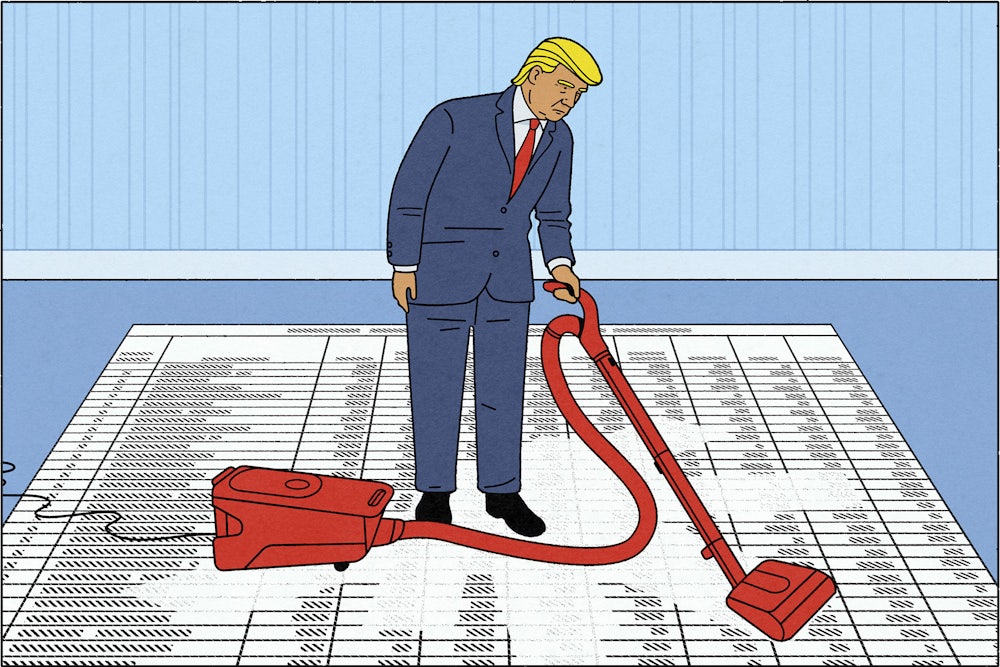For a president who’s talked constantly about winning, Donald Trump has so far been rife with losses—in the stock market, on the diplomatic front, in the courts, and in public approval. His first 100 days were nothing short of a disaster, hampered not just by Trump’s own ineptitude but by the ineptitude of his sycophantic subordinates and his presidential proxy, Elon Musk. Trump has fumbled peace talks between Israel and Hamas; alienated Ukraine while kowtowing to Putin; fired tens of thousands of workers (many of whom, following legal challenges, he has been forced to rehire); had his national security team publicly exposed as incompetent buffoons; thus far failed in his plans to capture Greenland or the Panama Canal; and stumbled into a global trade war that’s likely to drag down the entire economy. It would not be remotely surprising if the economy is in the midst of recession when voters head to the polls in November for the midterm elections. Things are currently going so badly, in fact, that a recession is far from the worst-case scenario.
Meanwhile, special elections in Florida and Wisconsin have suggested that voters are already fed up with the Trump administration and point to the possibility that the 2026 midterms could be a blue wave. As Trump’s failures continue to mount, Republicans have good reason to fear a backlash.
Perhaps this explains why Trump is intent on bolstering the election denial movement, which has lately notched a number of key victories. On March 25, the president signed Executive Order #14248, “Preserving and Protecting the Integrity of American Elections,” which neither preserves nor protects our elections but rather undermines them. It is a clarion call to Republicans throughout the nation, who are being encouraged to question the legitimacy of any election loss and ultimately establish a permanent electoral advantage by challenging and removing eligible voters from the rolls. Now, with Trump’s executive order, they have insurance: a way of tipping elections in their favor by choosing the voters rather than having the voters choose them.
The order instructs the U.S. Election Assistance Commission, or EAC, to amend its national mail voter registration form to require that all voters present documentation proving they are citizens, in the form of an ID that conforms with the REAL ID Act of 2005, a military ID, government-issued photo ID (all of which must indicate citizenship status or be accompanied by proof of citizenship), or a passport. A study from the University of Maryland found that this measure alone could disenfranchise approximately one in 10 voters—over 21 million Americans—who do not possess such documents and may have difficulty obtaining them.
The result is a poll tax of sorts that would add a cost to voting for those who would have to acquire new IDs, and disenfranchise those unable to acquire them or unaware of the new requirements—a burden that studies have found would fall disproportionately on voters of color, Democrats, and independents.
It’s not at all clear that the president has any power to issue such instructions in a country where elections are managed by the states and the bipartisan EAC. Richard Hasen, director of the Safeguarding Democracy Project at UCLA School of Law, believes many parts of the executive order are unconstitutional. The EAC “is an independent agency,” he said. Trump “may try to argue under the unitary executive theory that he has such power, but that will have to be resolved in the courts.” (Trump was dealt a blow on April 24, when a U.S. District Court judge halted the executive order’s proof of citizenship requirement.) Hasen characterized Trump’s executive order as a “power grab,” issued “perhaps in the hopes of influencing how future elections are run in order to try to help his preferred candidates and party win.”
Constitutional law professor Doug Spencer of the University of Colorado Boulder said that, while the EAC order is a “gray area,” he, too, fears that the likely result of any such effort would be to disenfranchise voters who have trouble proving their citizenship, putting an “onus” on voters to secure what should be an inalienable right. It’s “going to lead to many people who have a fundamental right not being able to exercise it,” he said, “and, in my opinion, that’s a problem for a country that wants to call itself a democracy.” Spencer also cautioned that it was far from obvious that the executive order would actually work as intended. In recent years, the Republican Party’s share of low-propensity voters—those who don’t consistently vote, a group disproportionately affected by restrictions—has grown significantly. In other words, the issuance of an executive order intended to make it easier for Republicans to win elections could ironically disenfranchise a growing part of its base.
But even if it does disenfranchise some Republican voters, the executive order goes further than simply making voting more onerous, providing several ways for Republicans to both win elections and challenge elections they have lost. It directs the U.S. attorney general to sue states that count mailed ballots that are postmarked before Election Day but arrive afterward, effectively killing vote-by-mail. It also mandates that state election officials share voter databases with the secretary of homeland security, and the administrator of the so-called Department of Government Efficiency, the cost-cutting commission run by billionaire Elon Musk, all of whom could challenge lists, potentially purging voters.
The penalty for noncompliance is extreme. The executive order instructs the attorney general to prioritize investigations into any state that refuses to comply with the information-sharing dictum, and to “review for potential withholding of grants and other funds that the Department awards and distributes, in the Department’s discretion, to State and local governments for law enforcement and other purposes.”
In other words, if state election officials refuse to comply with Trump’s unlawful edict to share their voter rolls with Elon Musk, among others, the attorney general could withhold law enforcement grants, which could lead to rising crime. It’s a threat, an effort to terrorize anyone who resists into submission.
“He’s going after the voter rolls in big cities, in blue states,” said Tabitha Bonilla, an associate professor at Northwestern University’s Institute for Policy Research. She sees the move as part of a larger pattern. “For more than a decade, the Republican Party has really pushed to put restrictions in place for voting.”
Hasen agrees. “The EO should be seen as part of a broader trend on the part of some Republican officials to try to make voting and registration harder,” he said, “as with the push to pass the SAVE Act.”
The Safeguard American Voter Eligibility Act, or SAVE Act, is essentially Trump’s executive order in legislative form, minus the major coercive components. It will undoubtedly face a filibuster in the Senate, which is why Trump issued the executive order. It nevertheless passed the House of Representatives on April 10 and, in the unlikely event that it becomes law, could also disenfranchise millions of voters. For instance, its requirement that a name on an ID, like a driver’s license, match that on a birth certificate could prevent millions of married women from being able to vote.
Voter purges like the ones Trump is encouraging are, as Bonilla indicated, nothing new, but they have been accelerating. The Brennan Center has noted that “jurisdictions have substantially increased the rate at which they purge voter rolls” over the past couple of decades. This did not abate in the lead-up to the 2024 election, when Republicans across the country purged voter rolls in an attempt to improve their odds of victory, with varying degrees of success.
In recent years, Republicans have weaponized this process, however. In North Carolina, for instance, officials removed 747,000 names from their rolls prior to the 2024 election. They claimed they were just doing routine maintenance, and two-thirds were removed because they had died or moved. But the others—more than 200,000—were removed because the state has aggressively gone after voters deemed “inactive” in recent years.
The state’s Republicans are currently trying to go even further, by challenging tens of thousands of votes that have already been counted. After losing a state Supreme Court election to incumbent Democratic Justice Allison Riggs by just 734 votes, Republican Jefferson Griffin is seeking to challenge the eligibility of more than 65,000 votes. As crazy as it sounds, he may very well prevail. He has already gotten one lower court to rule that all of those voters must prove their eligibility for their ballots to be counted. The North Carolina Supreme Court, which currently consists of five Republicans and one Democrat (with Riggs recusing herself from the case), ruled to accept 60,000 ballots. A federal judge is now set to determine the fate of the rest.
North Carolina is an extreme example, but it is hardly unique. In Georgia, for instance, 455,000 names are set to be removed from the rolls this summer, many of whom should be eligible voters. Purging nearly half a million names from the rolls isn’t enough for Republicans in the state’s House of Representatives, who are attempting to cut ties with the Electronic Registration Information Center, or ERIC, a nonpartisan group that helps states maintain voter rolls. A cursory look at nine red states that have recently broken with the organization reveals why: Nearly all of them have replaced ERIC with alternatives that make it easier to purge voters.
Trump’s executive order is an attempt to centralize and nationalize this game plan: reduce the number of voters likely to vote Democratic to begin with, challenge any reasonably close elections that you lose, and make voters who voted against you prove they were eligible after the fact. It’s not a new effort, Bonilla explained, but one that “reenforces the movements that are already underway … to continue to remove people.” It would also likely dramatically expand those movements by introducing them in states where voting rights are far more expansive than they are in states like North Carolina and Georgia, where mass purges are commonplace. If Trump were to succeed in claiming vast powers to decide who can and can’t vote, it would effectively amount to a hostile takeover of American democracy.
Still, this executive order can—and likely will—be weaponized, even if none of its draconian measures ever come into effect. Say the Democrats win back control of one or both chambers of Congress in the midterms. Trump may very well argue that they did so only because they refused to comply with its dictates, indicating widespread fraud, and he may potentially use that as a pretext to order the attorney general to stop states from counting ballots that arrive after Election Day. It is a way to delegitimize election results Trump doesn’t like—and might even be a pretext to attempt to overturn the results themselves. It’s the culmination of an election denial movement that has only grown stronger after January 6.
Most Republicans today still do not believe that Trump lost in 2020. His preposterous lies about elections rigged by unscrupulous bureaucrats and foreign invaders are now treated as gospel by much of a Republican base that is primed to doubt the legitimacy of any election the party loses. Led by a president who cannot countenance the idea of losing, Republicans are working tirelessly to ensure the party never does.
For Trump, this is a question of existential importance, and not just because he doesn’t want Democrats to regain power and litigate everything he’s doing as president. The last time he lost power, after all, he quickly found himself embroiled in several criminal and civil cases, some of which related to his conduct as president. He may have ended up being sentenced to prison had he not won the 2024 election. He believes his political rivals were directly responsible for the legal problems that ensnared him after he left office in 2021 and likely fears returning to life as a private citizen under a Democratic president.
He’s also spoken recently of seeking out a third term, despite the apparent constitutional restrictions on doing so. If he decides to actually pursue this route, surely it would be nice for him to know that he’d be starting off with a field goal–like advantage, and that, if he loses, he can simply direct the attorney general to start challenging every vote that went against him. That seems a much easier route than the last time he tried to overthrow the government.






